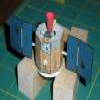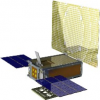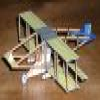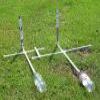| | Browse Files | |
| Bomarc CIM-10A stomp rocket (update) | ||
 Rating: 0 Favourites: 0 Report File |
Bomarc CIM-10A stomp rocket (update)File Information
Files
|
More From This User |
|
Update of the Bomarc strategic surface to air missile (SAM) with a more accurate and sturdier tail group. Model is designed to be launched as a stomp rocket (plans for launcher included). Approx 1:40 scale - size determined by 1/2 PVC launch tube.
Additional stomp rockets are in the Real Space (ARES I, Nike ZEUS SAM) and Toys and Automata (basic stomp rockets) download sections. The Bomarc missile was a US Air Force missile, originally given the designation F-99 as a fighter-interceptor that just happened to be unmanned. The missile's design bridged the WWII and Cold War eras and it was operationally deployed from 1959 to 1972 in the US and Canada. With planners envisioning massed 1000-plane bomber raids, the 45 foot long Bomarc was designed to launch on its tail rocket engine, then transition to two ramjet engines to cruise at Mach 3 to its target up to 100,000 ft and over 400 miles away. Once the missile intercepted the bomber formation, the missile detonated its 10kt nuclear warhead, destroying the formation and anything else nearby. The missile could also be equipped with a 1000lb conventional warhead - for perspective current SAM warheads are well under a hundred of pounds of explosive and are designed to hit a single target directly or detonate within a few meters. Trimming the missile for flight. The model can be made of 65 or 110lb card, the heavier stock will provide more durability with the inevitable hard landings. The model should be launched with an easy stomp on the launcher bottle - this will provide a good launch while not greatly exceeding the models best glide (trim) speed. Start soft and work your way up, observing how your missile behaves. Control surfaces should be as straight as possible - stability will come by trimming the center of gravity (CG). Any deflection of the tail surfaces or wings will result in greatly amplified forces when launched from the stomp rocket launcher. This can be entertaining, but will not give you a long, stable flight. Balance the model: put a dowel on your workbench and set the model crosswise on the dowel (start under the ramjet engines). Slowly roll the dowel toward the high end until the model tips down - note this point. Now, roll the dowel back until the model tips again - your center of gravity is halfway between these two points. Check it by balancing the model on the edge of a thin steel ruler - the flat surface provides just enough support for stability while being thin enough to precisely locate the CG. The model seems to fly best with the CG in the middle of the markings on the top of the wings (USAF and winged star). Most likely, you'll need to add some weight to the nose. You can glue a couple of thick card disks to the front of the pressure tube or stick a bit of clay there - where it will be hidden under the removeable nosecone. In the unlikely event you need to add weight to the tail, you're best option is probably to put some bits of clay (equally split right and left) into the tail ends of the ramjet engines. |
||








 28900-BomarcStompRocket-v2.pdf
28900-BomarcStompRocket-v2.pdf




